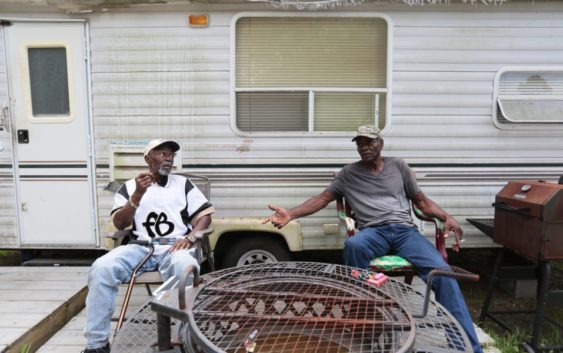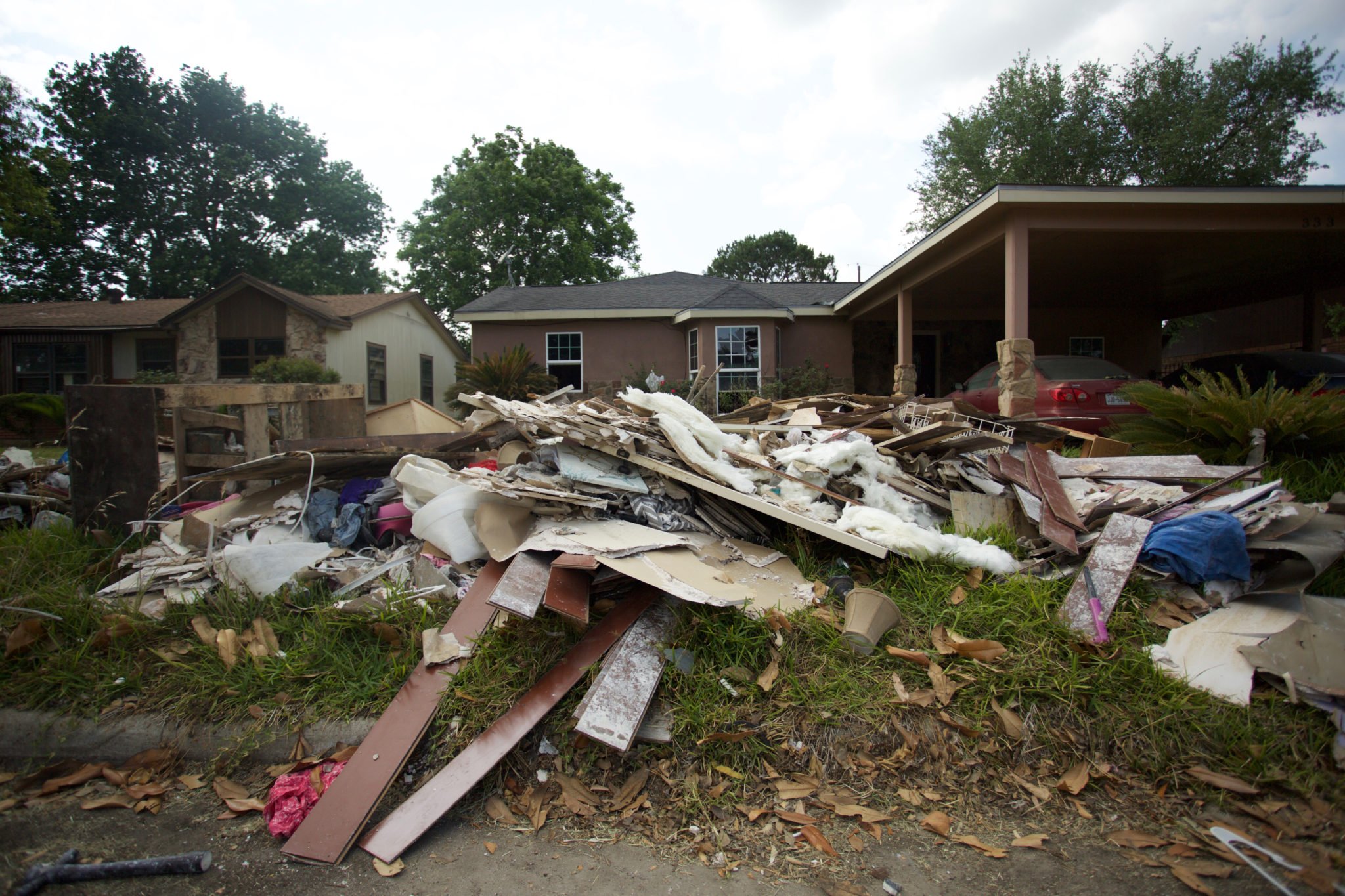- Severe weather threat this weekend
- The Pick of the Week today; severe weather chances by the end of the weekend
- Chimney Rock business rebuilds with state support after hurricane
- One year after devastating Panhandle wildfires, Canadian resident reflects on the work of rebuilding
- Hays County judge says software glitch caused some communication issues during wildfires
‘You Can Only Take So Much’: Low-Income Hurricane Harvey Survivors Sue Over ‘Discriminatory’ Recovery Process

The lawsuit accuses state and federal officials of favoring wealthier, white homeowners over poorer black and Hispanic renters.
Former city council member John Beard has a term to describe Port Arthur residents. In his Gulf Coast city of 55,000, people have all but given up on getting the help they need to recover from the storm that damaged or destroyed about 80 percent of housing, turning neighborhoods into lakes. Beard calls the city’s residents “Harvey-fatigued.”
In the majority-minority city, home to oil refineries and one of the highest unemployment rates in the state, many residents can’t afford to rebuild their homes or relocate more than two years after Hurricane Harvey. Some are still living in moldy, barely habitable houses that haven’t been gutted, or have been gutted but not reconstructed, Beard says. Others haven’t returned since fleeing the city two summers ago. Many are still stuck waiting for government help. “They filled out applications ’til they got writer’s cramp, they read paperwork ’til they got bleary eyed,” Beard says. “They’re really just worn out. … You can only take so much.”
Beard has seen Port Arthur struggle to recover from a slew of storms in recent years—Hurricanes Rita, Ike, and Harvey—each one hitting as residents are still trying to repair the damage of the last. Since Harvey, Beard has fought to have his community’s voices heard. He started the Port Arthur Community Action Network, an advocacy group to help residents through the convoluted, bureaucratic system of government grants. He’s spent hours at city hall speaking to council members. And he’s warned anyone who’ll listen that that his city’s very existence hangs in the balance.
Now, he’s helping to sue the state and federal governments over what he says is an unfair, discriminatory recovery process.
 A year after Hurricane Harvey, Port Arthur was still littered with debris. Michael Barajas
A year after Hurricane Harvey, Port Arthur was still littered with debris. Michael Barajas
“Storms don’t discriminate; it rains on all of us,” says Beard, who feels lucky that Harvey flooding in his home only reached his ankles. “But when it comes to money, and who’s going to get the resources and the help they need, elected officials and decision-makers most definitely discriminate.”
A new lawsuit against Texas’ General Land Office (GLO) and the U.S. Department of Housing and Urban Development (HUD) alleges racial discrimination in the allocation of billions of dollars in federal Harvey recovery aid. Filed late last week on behalf of low-income people of color in Beaumont, Houston, Galveston, and Port Arthur, the suit argues that the state’s plan for distributing $5.6 billion in disaster relief funds, drafted by GLO and approved by HUD, favors wealthier, predominantly white homeowners over poorer renters of color. This isn’t new: For years, storms have flooded poor Texas communities like Port Arthur, compounding damage residents couldn’t afford to repair from the previous disaster. Blue FEMA tarps dotted homes across Port Arthur even before Harvey; now city officials worry that residents who moved away won’t come back.
“There’s a new policy, a new plan for each disaster. … [But] we’re getting the same result after each storm,” says Ashea Jones, staff attorney at Lone Star Legal Aid, who filed the case. “Those who need the funds the most—federally subsidized renters, renters in general, predominantly minority communities—they are not receiving an equitable share.”
Asked to comment on the lawsuit, GLO spokesperson Brittany Eck said the agency has “undertaken very impressive efforts” to rebuild rental units in the 48 affected counties, excluding Harris County and the city of Houston, which are each directly allocating HUD funds. She said GLO is currently using $450 million to rebuild 68 housing developments, or 4,786 rental units, about 80 percent of which will be reserved for low-to-moderate-income renters. (As of October, fewer than half the new projects had started construction, per GLO.)
But it’s an ongoing, slow-moving process that advocates say has left many without options, low-income renters in particular. According to the lawsuit, the state has allocated three-quarters of the relief funds for homeowners—a group that includes 73 percent of white, non-Hispanic households in the disaster area—and one quarter to renters, who are disproportionately people of color. Homeowner funds include direct payments to individuals, but renter funds do not. Instead, renter funds go to developers to acquire or build rental units rather than to individual renters to help them relocate, pay for temporary housing, or repair damage.
The plaintiffs also argue that the state plan arbitrarily underestimates the needs of poor, minority households. For example, GLO doesn’t count damage claims below $8,000 for homeowners or $2,000 for renters, which undercounts poor communities with low property values.
And though wealthier people can more easily afford to buy flood insurance and spend savings on repairs, poor folks who are overlooked or don’t get the full funds they need are often stuck—unable to relocate, fix their home, or replace their belongings. Angenitta Delores Oaks, a plaintiff in the case, lost most of her belongings when her Houston rental flooded during Harvey. Her floors, refrigerator, and oven were damaged; roaches infested the apartment. But her landlord didn’t make the needed repairs, and she couldn’t afford to move. So for more than a year, the lawsuit states, Oaks stayed in the unit, where she couldn’t keep food because of the damaged appliances.
“Low-income communities have less access to private funds, whether in savings or access to credit or loans, to recover,” Jones says. “Over time the issues compound over and over, as we’ve seen in Port Arthur.”
Still, Beard—whose organization is a plaintiff in this case—says the lawsuit doesn’t address other serious issues his city still faces, like confusion over home buyouts and serious problems with drainage in many neighborhoods. When new storms come, Port Arthur won’t be prepared to handle them, and Beard says he feels his community has once again been forgotten.
 Beatrice Sanders now lives in a home elevated six feet off the ground in Port Arthur’s Montrose neighborhood. Michael Barajas
Beatrice Sanders now lives in a home elevated six feet off the ground in Port Arthur’s Montrose neighborhood. Michael Barajas
Beard remembers helping Beatrice Sanders, a now-72-year-old Port Arthur resident, try to get aid to rebuild her home almost 10 years ago, when he was still on city council. Sanders’ roof was damaged by Hurricane Dolly in 2005; three years later, Hurricane Ike flooded her home. For years, she waited for government assistance. Unable to pay for the full repairs or leave the home she owned for more than four decades, she and her family fixed what they could and continued living in the storm-struck house. Sanders was still waiting for help when Hurricane Harvey sent floodwaters up to her roof.
When the Observer visited a year after Harvey, Sanders was still living in a FEMA trailer parked outside her rotting shell of a home. Months later, a government disaster recovery program finally paid to build her a new house, but it was constructed in the same place, on stilts 6 feet off the ground, in a flood-prone neighborhood that Sanders later learned was being considered for buyouts.
This September, her neighborhood flooded again. Tropical Storm Imelda surrounded Sanders’ new home, nearly leading her to evacuate. “I know this is God’s work but I am getting too old for this,” she texted my colleague Michael Barajas. “Can’t hardly stand much more.”
Read more from the Observer: